Stage 1: Understand Problem to Grasp Desirability
The first stage is the most important stage of any endeavor. It is the crux of your endeavor. This stage will help you have a clear vision as to WHY your idea is important and WHO the primary beneficiary of your solution is. Answers to questions raised in this stage help in setting the vision and rationale behind your quest. Unless you have a clear idea of who the stakeholders are for whom you are solving a problem and what those problems are, it is impossible to envision a solution that would benefit the stakeholders.
By following the subsequent steps, you will develop a solid understanding of why the problem is worth solving. That is, the “desirability” of solving the problem for the user.
The first step is to have a clear understanding of the stakeholders involved around your problem statement. Stakeholders are all the persons who would be the direct beneficiaries of your solution or would be directly or indirectly affected by your idea. Think about the people who have a problem that you are solving, or those who would be paying for the solution or who will be directly or indirectly impacted by the problem you have identified or the solution that you would propose. All those are stakeholders for your idea.
Using the “Template 2 Stakeholders Map,” identify all the core, direct and indirect stakeholders for your idea.
Target stakeholders are the primary beneficiaries of your idea. Identify minimum of one and maximum of three core stakeholders who will also be the users of your solution.
Connected stakeholders are all the stakeholders who are connected to the target users and are thereby directly influencing or being influenced by your target users in the context of your idea. These are also the stakeholders who might be paying or helping implement the solution that you’ll be envisioning. Note that in many cases, the one who pays for the solution may not necessarily be the one who uses it. And the one who implements the solution may be a totally different person.
Influenced stakeholders are all other identified stakeholders who influence or are indirectly influenced by your target users or connected stakeholders. The reason to think of all the connected and influenced stakeholders is to have an exploratory approach to the problem space and not look at the problem space only through the narrow lens of identified target stakeholders.
3.1.4 Stakeholder Template (Figure 3.1)
Here is one example of stakeholders if your problem statement is:
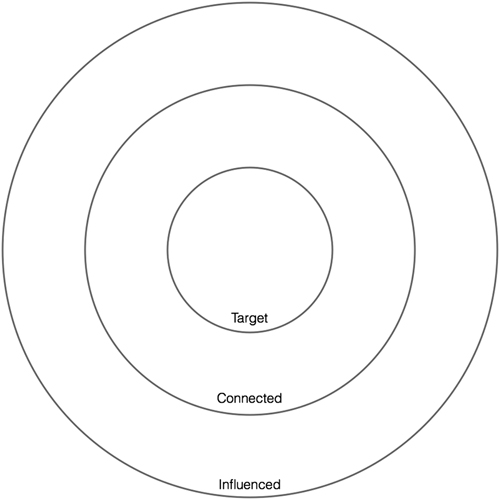
Figure 3.1 Stakeholders.
How might we enable stay-at-home moms who love cooking to sell their cuisines to working professionals who do not have time to cook and wish to eat home-cooked meals? (Figure 3.2)
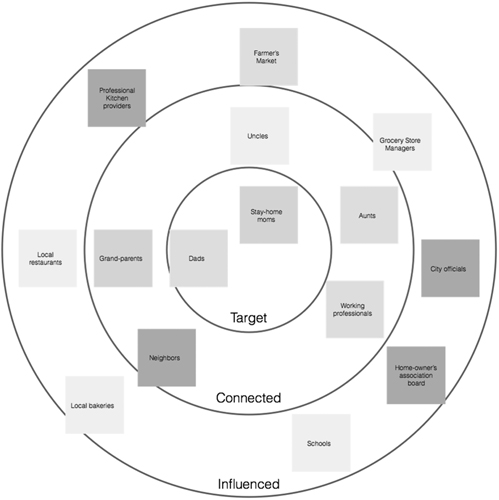
Figure 3.2 Stakeholders example.
In this case, target stakeholders could be stay-at-home moms, aunts, dads, grandparents and working professionals.
Connected stakeholders could be family members, neighbors for the cook and co-workers for the working professionals.
Influenced stakeholders could be homeowners’ association managers, local regulators, grocery stores, vegetable providers, meat providers, professional kitchen providers and others.
Draw the template on a flip chart/whiteboard.
Ask participants to identify all stakeholders who:
■ Have a problem that you are solving.
■ Are the primary users/beneficiaries of your solution.
■ Could benefit in any other domain, function or industry. (Thinking about beneficiaries in domains other than the one you are thinking of directly also helps in stirring up new ideas of applicability of your solution.)
■ Will pay for the solution. (Buyer may be different than the user.)
■ Will implement the solution. (Is there another stakeholder who will make the solution ready for use?)
■ Are directly impacted by primary users of your solution.
■ Are indirectly impacted by primary users or your solution.
3.1.5.2 Three-minute Self-brainstorm
All participants think of the stakeholders without talking with each other.
All participants write one stakeholder name per sticky note.
The facilitator asks each participant to place the stakeholders one by one and places the stakeholders in the appropriate category (target, connected and influenced).
The team should come to a consensus on the stakeholders and their placement on the template. The team should also identify at least one and no more than three target stakeholders for the problem space. We also call them users.
After agreeing on the stakeholders, the session lead should ask the team to write down all the assumptions that you are making and record those assumptions in the assumptions template in Chapter 6.
At this point, it is suggested to review the problem statement to ensure it is still valid. Adjust the problem statement as needed with the consensus of the team.
Many entrepreneurs jump into solving the problems from day one without adequately understanding the needs of the primary beneficiary of the imagined solution, the context in which the user operates, the wider context, including competitive options, behavioral trends, technology trends, industry trends and other relevant aspects.
Spending some time in conducting research about these aspects will help guide your thinking in the right direction. Research also gives you valuable insights into the needs of the users.
Business Context in step 13 will guide you through the macro context in which you are operating. In this step, you’ll focus on the core user and how to research to uncover real needs of the user.
User research is “the single most” important aspect of any project. If done right, you are likely to uncover insights that will enable you to address real needs of the user. The main objective of research is to “empathize” with the users/core stakeholders. There are three important aspects of user research:
1. Planning
2. Observation
3. Engagement
Before you go out for user research, it is important to plan the research. Think about all the avenues of primary and secondary research. Primary research entails directly observing and interviewing the users. Secondary research includes finding out information from other sources, including online, other people who would know the space better, books, library and media.
For primary research, you need to find and narrow down where to find the users to observe and research. The best approach is, if you already know people in this space, to reach out to them directly. Otherwise, find out ways to reach out to the users and explain why you need their time and how the research will help you in understanding their needs better.
Observation pertains to viewing users and their behavior in the context of their lives/work. Watching what people do and how they interact with their environment gives you clues about what they think and feel. It helps you to learn about what they need. By watching people, you can capture physical manifestations of their experiences, what they do and say. This will allow you to interpret the intangible meaning of those experiences in order to uncover insights. These insights will lead you to innovative solutions. The best solutions come out of the best insights into human behavior.
But learning to recognize those insights is harder than you might think, because our minds automatically filter out a lot of information in ways we aren’t even aware of. We need to learn to see things “with a fresh set of eyes.” Tools for empathy, along with a human-centered mind-set, are what gives us those new eyes.
To have genuine curiosity, you must engage with users through empathetic questioning. Think of it as personally connecting with someone rather than interviewing or surveying someone. This mind-set allows you to seek the deeper insights and ask the harder questions. At the end of your time with a user, you want to have captured what that person said and did, and you want to have an understanding of what that person thinks and feels.
3.2.4 Being Inquisitive Is Good, Without Being Intrusive!
We want to understand a person’s experience as a user in the space so that we can determine how to innovate for him/her. By understanding the choices that person makes and the behaviors that person engages in, we can identify needs and design for these needs. Use this map to guide your interview:
■ Introduce yourself and your team.
■ Introduce the project and explain why you are doing the research.
■ Build rapport.
■ Do not go through the interview questionnaire question by question. Instead, have the questionnaire as a guide and have the engagement as a conversation.
■ Listen to the user responses intently to understand rather than rushing to finish asking all the questions.
3.2.5 Adopt a Beginner’s Mind-set
We all carry our experiences, understanding and expertise with us. These aspects of yourself are incredibly valuable assets to bring to the design challenge – but at the right time, and with intentionality. Your assumptions may be misconceptions and stereotypes, and they can restrict the amount of real empathy you can build. Assume a beginner’s mind-set in order to put aside these biases so that you can approach a design challenge with fresh eyes. Be mindful of the following aspects:
Just observe and engage users without the influence of value judgments upon their actions, circumstances, decisions or “issues.”
Question even (and especially) the things you think you already understand. Ask questions to learn about how the user perceives the world. Think about how a four-year-old asks “Why?” about everything. Follow up an answer to one “why” with a second “why.”
Strive to assume a posture of wonder and curiosity, especially in circumstances that seem either familiar or uncomfortable.
Look for interesting threads, patterns and themes that emerge across interactions with users.
Lose your agenda and let the scene soak into your psyche. Absorb what users say to you, and how they say it, without thinking about the next thing you’re going to say.
3.2.11 Suggestions for User Engagement
Ask why. Even when you think you know the answer, ask people why they do or say things. The answers will sometimes surprise you.
Encourage stories. Whether or not the stories people tell are true, they reveal how they think about the world. Ask questions that get people telling stories.
Look for inconsistencies. Sometimes what people say and what they do are different. These inconsistencies often hide interesting insights.
Listen to nonverbal cues. Be aware of body language and emotions.
Don’t be afraid of silence. Interviewers often feel the need to ask another question when there is a pause. Sometimes if you allow there to be silence, a person will reflect on what they’ve just said and say something deeper.
Don’t suggest answers to your questions. Even if they pause before answering, don’t help them by suggesting an answer. This can unintentionally get people to say things that agree with your expectations.
Ask questions neutrally. “What do you think about this idea?” is a better question than “Don’t you think this idea is great?” because the first question doesn’t imply that there is a right answer. Don’t offer approval or disapproval with words, facial expressions or body language.
3.2.12 Engagement Guidelines with the User
Prepare a list of questions before the interview.
Two to three people should go for the engagement.
The team should be prepped on the engagement model and preferably trained on empathy-based engagements.
The team should interview three or more users in the same role and synthesize those insights afterward.
It is recommended to assign a dedicated interviewer and note taker for user research.
3.2.12.1 Guidelines for Interviewer
■ One person should take the role of interviewer who will drive the questioning.
■ Ask open-ended questions.
■ Review the guidelines mentioned above.
■ Do not go through the interview questionnaire question by question. Instead, have the questionnaire as a guide and have the engagement as a conversation.
■ Listen to the user responses intently to understand rather than rushing to finish asking all the questions.
3.2.12.2 Guidelines for Note Taker
■ Other person(s) should be solely responsible for taking notes.
■ Only ask questions for clarification.
■ Use the “Observation Template” and “Note-Taking Template” to record the observations and answers.
■ Take pictures of the surroundings and the user with his/her permission.
■ Review the guidelines mentioned above.
3.2.12.3 Sample Questions for Interview
Sample questions for an enterprise engagement include the following:
1. Introduction:
a. Tell me about yourself.
b. What is your educational background?
c. How long have you been in this role?
d. What did you do before this job?
2. Jobs to be done:
a. Tell me about your role.
b. What are your responsibilities?
c. Who is your manager, and how does he/she measure your performance?
d. How do you fulfill your responsibilities today?
e. Whom do you rely on to do your job?
i. Which other people within and outside your team?
ii. Which information do you rely on?
iii. How do you get that information?
iv. Do you know how this information was generated/aggregated?
v. Do you trust the information?
vi. How soon do you see that information?
vii. What do you do with that information?
viii. Do you massage the information in a certain way yourself to have a better understanding of the reality?
ix. Can you show us how you do that?
x. Can you show us how you see the information today?
f. What decisions do you have to make daily/weekly/monthly/quarterly/yearly?
g. Whom do you interact with to make your decisions?
h. How much of the decision making is subjective, based on your experience?
i. How would someone with much less experience than you have make such decisions?
j. How do you know that the decisions that you made had a positive or negative impact?
k. Can you walk us through the major tasks you do? We’d just shadow you and make observations and ask questions to have a better understanding of your challenges.
3. Customers:
a. Who are your customers?
b. Tell me more about your customers – are they both internal and external?
c. What do these customers expect of you?
d. What are their biggest challenges?
e. What is the job that you are helping your customer do?
f. How else can your customers do their job if you did not provide the product/service?
4. Challenges:
a. What are your biggest challenges?
b. Why are you facing these challenges?
c. How many of these challenges are related to organization?
d. How many of these challenges are related to processes?
e. How many of these challenges are related to technology?
5. Aspirations:
a. In an ideal world, how would you be doing your job?
b. What are the factors that you would like to maximize in your job?
c. How would you solve the challenges you identified earlier on?
6. Evoke stories throughout the interview:
a. Tell me about a time when … ?
i. Tell me about a time when things didn’t go as planned?
ii.Tell me about a time when things worked better than expected?
7. Understand emotions:
a. How did you feel when this happened?
b. Tell me more about how you felt at that point?
8. Conclusion:
a. Thank the user for his/her time.
b. Tell the user about the next steps:
i. What you will do with all this information and when they can expect to hear some progress on the research.
ii. You’ll be interviewing other users as well.
iii. You’ll be synthesizing this information.
iv. You’ll be coming back to them for validation.
v. You’ll be thinking about new ways to do things/solutions.
vi. You’ll be inviting them for their input on new solutions.
vii. You’ll be prototyping new solutions and sharing them with users to get feedback.
viii. You’ll be prioritizing use cases across all verticals.
ix. You’ll be building solutions for them if their area was selected as the top use case.
c. Thank them again for their time and openness.
Capture your insights on the following template, from observation to interpretation and deriving insights (Figure 3.3).
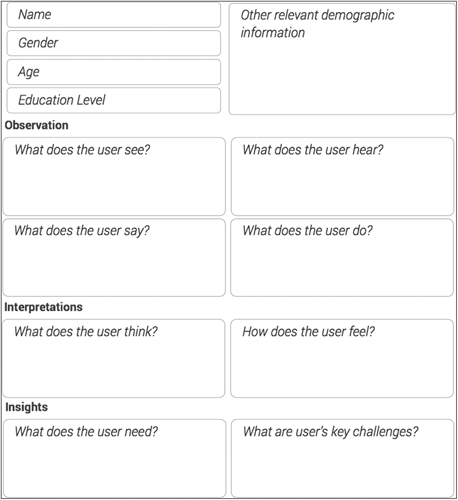
Figure 3.3 Empathy template.
Bring notes back from the engagement and complete the Template 4 Empathy Map.
Session Lead

Figure 3.4 Empathy example.
For each user research, draw the template on a flip chart/whiteboard. Use one color of sticky notes for each user interviewed (do not mix colors).
Ask participants to record their research in this template:
Observations
■ What was the user doing?
■ What was the user uttering/saying?
■ What was the user seeing?
■ What was his/her environment?
Interpretations and/or answers
■ What are the user’s thoughts?
■ What are the user’s feelings?
Insights
■ What are user needs and challenges?
10-minute self-brainstorm
■ All participants document their user research insights on sticky notes.
The session lead asks everyone to come to the flipchart and paste their thoughts.
All Users
Repeat the brainstorming session for all the users researched. Use different color sticky notes for recording research insights from each user.
Synthesize
Ask everyone to bring insights from the different users into one empathy map. The team should be able to see common themes emerging across different users as well as unique insights from individual users. These insights should be discussed in order to further develop empathy with the user and generate ideas.
After the session, the session lead should ask the team to write down all the assumptions that you are making and record those assumptions in the assumptions template in Chapter 6.
Persona is a fictitious representation of the main user who would be using your product or service. Bring the insights from user research to life and build a fictitious persona for each of your core users.
Use this template to build your user’s persona (Figure 3.5).

Figure 3.5 Persona template.
Here is an example of a persona for a user (Figure 3.6).
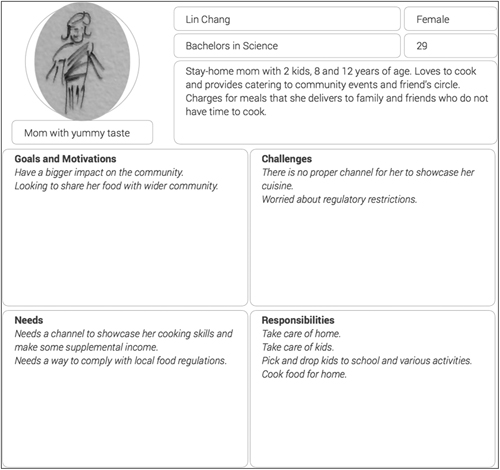
Figure 3.6 Persona example.
Session Lead
As a team, give this persona a name. Agree on the age, gender and education level.
10-minute self-brainstorm
Give everyone 10 minutes to put their thoughts on sticky notes to capture the following aspects for the persona:
■ Goals and motivation in the context of your idea.
■ Challenges faced to achieve these goals.
■ Primary responsibilities for the persona in the context of your idea.
■ Needs.
Team Brainstorm
The session lead asks everyone to come to the flip chart and paste their thoughts.
After all the team members have shared out, cluster the input and agree on the key aspects of the persona so that the whole team is on the same page.
Draw a sketch that represents the persona and give a creative tag line that captures the essence of the persona. Have some fun while doing this exercise.
All Users
Repeat the brainstorming session for all the users for your idea. Build one persona for each user segment.
From now on, every time you discuss the users, use the persona’s name so that everyone on your team would have the same visual picture in their minds and have a similar understanding of the needs and context of the core user for your idea.
After the session, the session lead should ask the team to write down all the assumptions that you are making and record those assumptions in the assumptions template in Chapter 6.
Review the prior steps and adjust as needed with the consensus of the team.
To understand the user’s perspective and be in his/her shoes, build the customer journey in the context of your idea. The goal is to have a holistic and comprehensive understanding of the user’s context and build empathy with the user. Depending on the situation, you may sketch multiple customer journeys for each persona.
3.4.1 Current Journey Template
Document current journey in the following template (Figure 3.7).

Figure 3.7 Current journey template.
3.4.2 Current Journey Example (Figure 3.8)
Session Lead
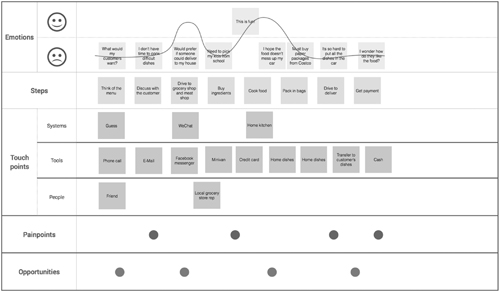
Figure 3.8 Current journey example.
Ask the team to write all the steps the user does in his/her journey.
■ List the steps the user takes in the context of the problem space.
■ For each step, identify touch points, which are systems, resources and people that the user relies upon to perform that step.
■ Then go through the user’s emotional state of mind while performing each step.
■ Give red and green voting dots to participants and ask them to highlight pain points and moments of truth.
■ “Moments of truth” are the points where the user is most susceptible to emotional influence.
Use different colored sticky notes for steps, touch points and emotions.
As you complete the journey map, go through the emotions and draw a line to depict highs and lows from users’ emotional aspects.
15-minute Self-brainstorm
Give everyone on your team fifteen minutes to jot down thoughts for steps, touch points and emotions for each user.
Team Brainstorm
Everyone comes to the board and explains each sticky note as they paste it on the wall.
The team should review the steps, touch points and emotions and move sticky notes around to reflect the journey of the user.
Use a marker to traverse the emotional state of the user throughout the journey to highlight the emotional journey of the user as well.
Once the journey map steps, touch points and emotions are completed, hand over red dots and green dots to each team member. Everyone should place red dots on sticky notes to indicate pain points for the user and green dots to indicate “moments of truth” for the user. Paint points are, as the name suggests, difficulties that the user encounters while going through the journey. “Moments of truth” are the points where the user is emotionally vulnerable. In other words, these are the points where you could influence the user the most.
Put yourself into the user’s shoes and walk through this journey to build empathy with the user.
After the session, the session lead should ask the team to write down all the assumptions that you are making and record those assumptions in the assumptions template in Chapter 6. In case there are disagreements about any aspect of the user journey, make an assumption of the most likely scenario and document that assumption in the assumptions section as well.
Review the prior steps and adjust as needed with the consensus of the team.
3.5 Step 5: User’s Perspective
The user’s point of view is a critical step in having a solid understanding of the problem you are trying to solve. The point of view is deeper than a statement summarizing the needs. It is full of insights that can only be extracted if you have really built empathy for the user. This is the opportunity to capture those nuggets of insights which form the basis of your idea. Craft these points of view in the following form:
User X needs a way to do a job because insight.
Capture user’s perspective in the following template (Table 3.1).
Session Lead
Table 3.1 User’s perspective template.

Table 3.2 User’s perspective example.
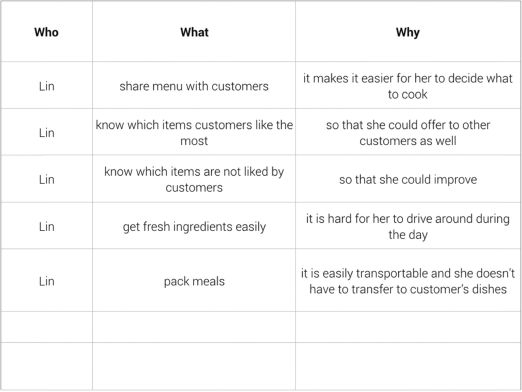
Ask the team to review the journey map and then write insightful points of view for the user.
15-minute Self-brainstorm
Everyone spends 15 minutes to come up with insightful user perspectives.
Team Brainstorm
Everyone shares their user perspectives and lists them in the order of importance for the user. Review all the perspectives and rank them in the order of importance. As you discuss these points of view, feel free to merge the insights and points of view as needed.
After the session, the session lead should ask the team to write down all the assumptions that you are making and record those assumptions in the assumptions template in Chapter 6.
Review the prior steps and adjust as needed with the consensus of the team.
